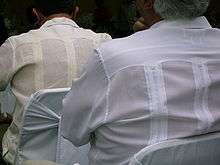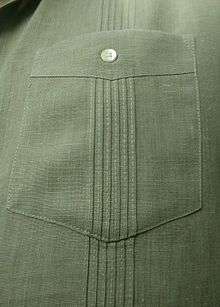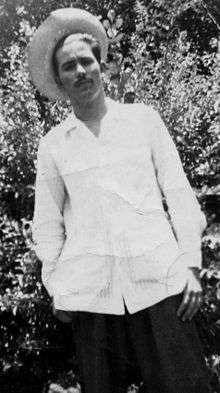Guayabera

The guayabera (/ɡwaɪ.əˈbɛrə/) a.k.a. Camisa de Yucatán (Yucatan Shirt) is a men's summer shirt, worn outside the trousers, distinguished by two vertical rows of closely sewn pleats running the length of the front and back of the shirt. Typically made of linen, silk, or cotton, and appropriate for hot or humid weather, guayaberas are popular in the Caribbean (especially Cuba), Central America, and Southeast Asia.
Design

The design of a typical guayabera is distinguished by several details:
- Long or short sleeves, the more common being the short-sleeved version, having a cuffed sleeve with a single decorative button.
- Either two or four patch pockets and two vertical rows of alforzas (fine, tiny pleats, usually ten, sewn closely together) run along the front and three along the back of the shirt. The pockets are detailed with alforzas that are identical to, and aligned with, the alforzas on the body of the shirt.[1]
- The top of each pocket is usually adorned with a matching shirt button, as are the bottoms of the alforza pleats. Vertical rows of adjusting buttons are often used at the bottom hem. While most versions of the design have no placket covering the buttons, a few newer designs do.
- Some shirt designs include slits on either side, and these include two or three buttons. The bottom has a straight hem, and is never tucked into the trousers.[2]
Though traditionally worn in white and pastels, guayaberas are now available in many solid colors. Black guayaberas, embroidered with colorful flowers and festooned with French cuffs, have for many decades been extremely popular in Mexico and are considered formalwear in some situations.[3]
Mexican guayaberas often use complicated embroidery as a supplement to the traditional alforzas. This style originated in Mérida, Mexico.[2]
History

The exact origin of the garment is unknown. Various claims for the style have been made, including that:
- It originated in Cuba, moving from there to Mexico. Cuban literature refers to the shirt as early as 1893,[4] and documentary evidence mentions the shirt in Cuba as early as 1880.[2] The Cuban origin story tells of a poor countryside seamstress sewing large patch-pockets onto her husband's shirts for carrying guava (guayabas) from the field.[5][2] In another version of the story, in 1709 Spanish immigrants from Granada, José Pérez Rodríguez and his wife Encarnación Núñez García arrived in Sancti Spiritus, located along the Yayabo River. José asked his wife to make him a shirt with long sleeves and four large pockets to store his cigars and belongings while he worked. Because it was easy to make and useful, it soon became a popular garment in use in that region. The name guayabera is said to have originated from the word yayabero, the nickname for those who lived near the Yayabo River in Cuba.[5][6][7]
- Mexicans claim it originated in either the state of Veracruz or the Yucatán Peninsula.[5] (In Mexico, the same basic style is also known as the "camisa de Yucatán" (Yucatán shirt)[8] or "wedding shirt".[2])
- The Philippine barong tagalog, which has documented origins in the Philippines prior to the arrival of the Spanish,[9] made its way to Cuba through Mexico via the Manila-Acapulco galleon trade.[5] However, some scholars doubt this. The barong, as worn before the Spanish, does not resemble the guayabera, as it has no pockets, is not completely open in front and has a circular U shape embroidery around this, a similar concept but one which makes this direction of influence less likely.[10]
Wear and use
The guayabera is often worn in formal contexts, such as offices and weddings. In Cuba, the Dominican Republic, Mexico, and Puerto Rico, guayaberas are part of the traditional wear for men and may be considered formalwear.[11][6] In 2010, Cuba reinstated the guayabera as the "official formal dress garment".[12]
Political symbolism
_(2).jpg)
Guayaberas have been worn extensively by a number of Latin American political leaders, including César Chávez, Carlos Prío Socarrás, and Fidel Castro.[7] This is often interpreted as a sign of the wearer's affiliation with populist political positions.[11] Michael Manley, populist Jamaican prime minister, specifically advocated for the guayabera as an anti-colonialist mode of dress,[13] and conversely the shirt was later banned in Parliament by the conservative Jamaica Labor Party.[14] Similarly, Mexican populist Luis Echeverría advocated for its use in Mexico in part to symbolize rejection of European and American-style business suits.[8][2]
.jpg)
U.S. presidents, including Ronald Reagan, George H.W. Bush, and Barack Obama, have worn the shirts as a sign of solidarity when visiting the Cuban community in Miami[15] and when attending Latin American summits.[7] Visiting politicians are sometimes given the shirts by Cuban American or Latin American political leaders.[16][17]
Similar shirts and alternative names
A variety of similar, lightweight dress shirts exist in other tropical countries. These include:
- In the Dominican Republic: a similar or identical shirt is also called "chacabana".[18][19]
- In Guyana: a similar or identical shirt is called a "shirt-jac".[20][21]
- In Jamaica: the guayabera is called a "bush jacket".[13]
- In the Philippines: the barong tagalog shirt has some features which are similar to the guayabera: it is long-sleeved, light, traditionally white, and worn without being tucked in. However, the most traditional styles are decorated with "U" shaped embroidery (called the pechera), rather than the guayabera's straight pleats, and lack pockets.[22] It is also traditionally made of hand-woven, fine, translucent piña or jusi fiber, rather than linen.[9]
- In America: the Western shirts with pointed yokes and elaborate embroidery were directly copied from the guayaberas of 19th century Mexican vaqueros.[23][24] These serve as the national costume of the Southwestern United States.[25][26]
References
- ↑ Tartakoff, Joseph (2006-09-13). "The guayabera: Traditional tropical shirt finds new customers online". Mas Magazine. Archived from the original on 2008-09-10.
- 1 2 3 4 5 6 "The Guayabera: A Shirt's Story". HistoryMiami. Archived from the original on 2016-07-18. Retrieved 2015-04-10.
- ↑ "Guayaberas: Fashion Statement for Men". PuertoRico.com.
- ↑ "Guayabera, The Beloved National Garment". CubaPLUS Magazine. Retrieved 2017-11-07.
- 1 2 3 4 Armario, Christine (30 June 2004). "Guayabera's Origin Remains a Puzzle". Miami Herald. Retrieved 10 April 2015.
- 1 2 Gray, Kevin (2003-05-23). "Cuban Guayaberas Make Mark Abroad". Havana Journal.
- 1 2 3 "Cuba y su guayabera, presentes en Cumbre de las Américas" [Cuba and its guayabera, present at the Summit of the Americas] (in Spanish). Escambray. 2012-04-10. Retrieved 2017-01-16.
- 1 2 Kiddle, Amelia Marie; Munoz, Maria Leonor Olin (2010). Populism in Twentieth Century Mexico: The Presidencies of Lazaro Cardenas and Luis Echeverria. University of Arizona Press. p. 198. ISBN 9780816529186.
- 1 2 Lynch, Annette; Strauss, Mitchell D. (2014-10-30). Ethnic Dress in the United States: A Cultural Encyclopedia. Rowman & Littlefield. ISBN 9780759121508.
- ↑ Martinez, David C. (2004). A country of our own: partitioning the Philippines. Bisayâ Books. pp. 244–245. ISBN 9780976061304.
- 1 2 Root, Regina A. (2005-06-04). Latin American Fashion Reader. Bloomsbury Academic. ISBN 9781859738931. Retrieved 2015-04-10.
- ↑ "Guayabera shirt now official Cuban formal dress code". BBC News. 2010-10-07. Retrieved 2012-04-09.
- 1 2 Ulysse, Gina A. (2007). Downtown Ladies: Informal Commercial Importers, a Haitian Anthropologist and Self-Making in Jamaica. University of Chicago Press. p. 77. ISBN 9780226841212.
- ↑ Waters, Anita M. (2017-09-08). Race, Class, and Political Symbols: Rastafari and Reggae in Jamaican Politics. Routledge. p. 194. ISBN 9781351495066.
- ↑ "Best Place to Buy a Shirt and Chat with a Legend (2002): La Casa de las Guayaberas". Miami New Times. Retrieved 2015-04-10.
- ↑ "After debate, Trump visits with the Hispanics who seem to like him most". Miami Herald. 2016-09-27. Retrieved 2016-09-27.
- ↑ "President Tsai attends panama canal cermony / 巴拿馬運河竣工 蔡出席見證拚外交 - PTS Good Morning Taiwan". 公視新聞網 (in Chinese). 2016-06-28. Retrieved 2017-11-06.
- ↑ Deive, Carlos Esteban (2002). Diccionario de dominicanismos (in Spanish). Editora Manati'. p. 104. ISBN 9789993439073.
- ↑ Moran, Patrick R. (2001). Teaching Culture: Perspectives in Practice. Heinle & Heinle. p. 104. ISBN 9780838466766.
- ↑ "Summit". Stabroek News. 2010-02-28. Retrieved 2017-11-07.
- ↑ Allsopp, Richard; Allsopp, Jeannette (2003). Dictionary of Caribbean English Usage. University of the West Indies Press. ISBN 9789766401450.
- ↑ Hila, Ma Corazon A.; Reyes, Mitzi Marie Aguilar; Feleo, Anita B. (2008). Garment of honor, garment of identity. EN Barong Filipino. pp. 63–69.
- ↑ The Western shirt
- ↑ "The Cowboys", part of Time and Life: The Old West (1973)
- ↑ The evolution of Western wear
- ↑ Cowboy clothing
External links
| Wikimedia Commons has media related to Guayaberas. |